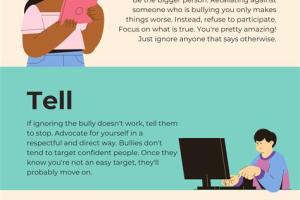Effective Strategies to Protect Yourself from Cyberbullying

-
Quick Links:
- Understanding Cyberbullying
- Recognizing the Signs of Cyberbullying
- Steps to Prevent Cyberbullying
- Building a Support System
- What to Do If You Are Being Cyberbullied
- Legal Aspects and Reporting Cyberbullying
- Expert Insights
- Case Studies
- FAQs
Understanding Cyberbullying
Cyberbullying is a form of bullying that takes place over digital devices like smartphones, computers, and tablets. It can manifest in various ways, including harassment, impersonation, or spreading false information. Unlike traditional bullying, cyberbullying can occur 24/7, making it more pervasive and often more harmful.
Statistics on Cyberbullying
According to a study by the Cyberbullying Research Center, approximately 36.5% of students have experienced cyberbullying at some point in their lives. This alarming statistic emphasizes the need for effective prevention strategies.
Recognizing the Signs of Cyberbullying
It is crucial to identify the signs of cyberbullying early to take appropriate action. Common signs include:
- Sudden changes in behavior or mood.
- Withdrawal from friends or activities.
- Unexplained anxiety or fear when using digital devices.
- Changes in sleeping or eating habits.
- Reluctance to share online activities.
Steps to Prevent Cyberbullying
Taking proactive measures can significantly reduce the risk of becoming a victim of cyberbullying. Here are some effective strategies:
1. Strengthen Your Privacy Settings
Ensure that your social media accounts are private. Adjust settings to limit who can see your posts and who can contact you.
2. Think Before You Share
Consider the potential consequences before posting anything online. Information shared in haste can be misused or taken out of context.
3. Educate Yourself and Others
Understanding the nature of cyberbullying is essential. Discuss the topic with friends and family and raise awareness.
4. Use Technology to Your Advantage
Utilize apps and tools designed to enhance online security and report bullying behavior. Tools like Bullying.org offer resources to combat bullying effectively.
5. Be Mindful of Your Digital Footprint
Every action online leaves a trace. Be mindful of your digital footprint and regularly audit your online presence.
Building a Support System
Having a reliable support system is vital in combating cyberbullying. Here are some ways to build your network:
- Communicate regularly with trusted friends and family.
- Join online forums or support groups focused on cyberbullying.
- Engage with community leaders and educators who promote digital safety.
What to Do If You Are Being Cyberbullied
If you find yourself a victim of cyberbullying, follow these steps:
1. Document Everything
Take screenshots of the bullying messages and keep a record of the incidents. This documentation can be crucial for reporting.
2. Report the Bullying
Use the reporting features on social media platforms to report abusive behavior. Most platforms take these reports seriously.
3. Block the Bully
Don’t hesitate to block or mute the individuals harassing you. This can provide immediate relief.
4. Seek Help
Talk to a trusted adult, counselor, or mental health professional about your experiences. Seeking help can provide both emotional support and practical advice.
Legal Aspects and Reporting Cyberbullying
Understanding the legal ramifications of cyberbullying is essential. Many jurisdictions have specific laws regarding online harassment. Here’s what you need to know:
1. Know the Laws in Your Area
Familiarize yourself with local laws regarding cyberbullying. Some areas have stringent regulations that can lead to criminal charges against the bully.
2. File a Report
If cyberbullying escalates to threats or harassment, don’t hesitate to file a report with law enforcement. They can provide assistance and intervene if necessary.
3. School Policies
If you are a student, report the incidents to your school. Most educational institutions have policies in place to handle bullying, including cyberbullying.
Expert Insights
Experts recommend a comprehensive approach to combat cyberbullying that includes education, prevention, and intervention. Dr. Sameer Hinduja, a leading researcher in the field, emphasizes the importance of fostering a culture of kindness online.
Case Studies
Examining real-world instances of cyberbullying can provide valuable insights into effective prevention strategies. In one case, a high school implemented a digital citizenship program that significantly reduced incidents of cyberbullying over two years.
FAQs
Below are some frequently asked questions regarding cyberbullying:
- What is cyberbullying? Cyberbullying is bullying that takes place over digital devices and includes harassment, impersonation, and spreading false information.
- How can I tell if someone is being cyberbullied? Signs include mood changes, withdrawal, changes in behavior, and reluctance to use digital devices.
- What should I do if I am being cyberbullied? Document everything, report the bullying, block the bully, and seek support.
- Are there legal consequences for cyberbullying? Yes, many jurisdictions have laws against cyberbullying that can lead to criminal charges.
- How can I protect my privacy online? Strengthen your privacy settings, think before you share, and regularly audit your online presence.
- Can I report cyberbullying on social media? Yes, most social media platforms have reporting features for abusive behavior.
- Is it necessary to talk to someone about cyberbullying? Yes, talking to a trusted adult or mental health professional can provide support and guidance.
- Can schools help with cyberbullying? Yes, most schools have policies and support systems in place to address instances of cyberbullying.
- What role do parents play in preventing cyberbullying? Parents can educate their children about online safety, monitor their online activities, and foster open communication.
- Are there resources available for victims of cyberbullying? Yes, organizations like StopBullying.gov provide resources and support for victims.
Random Reads
- How to get your sim pregnant sims freeplay
- How to persuade parents buy playstation
- How to use gameshark codes on visualboy advance
- How to use google drive
- Create a new command on autocad
- How to change year google maps google earth pro
- How to get all hms pokemon firered leafgreen
- How to win at simcity 3000
- How to win at voltorb flip
- How to connect to mifi